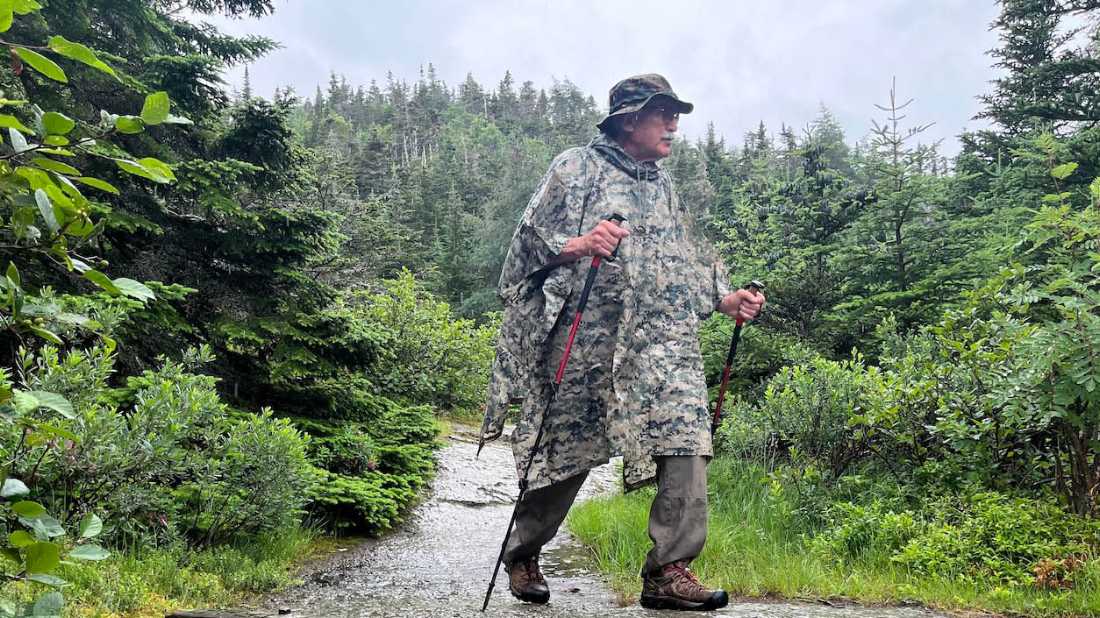
Robin hiking along the Atlantic coast in beautiful Newfoundland | Joe Kalmek
Blog home / The Long and Skinny Truth About Hiking Poles
By Robin Esrock
Some people swear by them, others think they’re entirely unnecessary. I first embraced hiking poles when I hiked the rugged West Coast Trail on Vancouver Island, about a year after breaking my kneecap in an accident. I highly recommend the West Coast Trail, a true bucket list wilderness experience. I highly recommend you not break your kneecap. Fully aware I was taking on a challenging hike with a bum knee, I knew that hiking poles could be crucial, so I got stuck into the research.

The walking stick is nothing new. Shepherds always used wooden staffs to navigate hills, savannah and mountains while tending their flocks. In the Alps, shepherds and guides navigated treacherous paths with long wooden poles, eventually adding metal tips to steady themselves across snowy passes and slippery glaciers. Then as now, finding the right stick was something of an art: it had to match the correct height of the user, be comfortable to grip, sturdy enough to absorb weight, and solid enough to beat off a predator. Sticks would be picked up and disposed of at the end of the day, or treasured, crafted and decorated. Over one hundred elaborate walking sticks and staffs were found buried in Tutankhamen’s tomb, befitting a pharaoh known to have a club foot.
Not much changed until the 1970s, when ski manufacturers adapted their ski-poles for summer use, adding innovations like height adjustments, comfortable grips, and lighter materials. After widespread adoption by hiking and endurance pros, poles quickly became a must-have accessory. Today, hiking poles are recommended for both day and multi-day hikers, and you’ll find them on offer at outdoor retail stores worldwide. Scientifically, the benefits are clear.

Hiking poles can reduce the cumulative stress on your knees by up to 25%, especially during downhill descents when forces can reach several times your body weight. Anyone with knee issues - or in my case, a broken knee - will find this extra support worth its weight in gold. By adding a third or fourth leg, the poles distribute weight and pressure across your body, while also reducing strain on your hips, feet and ankles. Unstable screes, marshy terrain and rocky descents become considerably safer with the added stability. Beyond your knees, the extra appendage greatly improves balance, especially if you’re navigating unstable ground, crossing streams, or scrambling over slippery rocks. The rhythm of pole planting, much like an elliptical machine in the gym, adds extra full-body workout points, increasing endurance and speed. By improving your upright posture, you can also significantly reduce exertion. Keeping your hands steady at your heart level has been shown to improve blood circulation and prevent swelling too.
Taken together, poles become a no-brainer when packing for a multi-day hike like the East Coast Trail, the Bruce Trail, the Tombstone Range and other itineraries. While you might not need them on a well-maintained short trail back home, hiking poles in the Canadian wilderness can make the difference between an enjoyable experience and a painful ordeal.

To get the maximum benefit, you’ll need to size your sticks correctly. The general rule: when you hold your poles with tips on the flat ground, your elbows should be at a 90-degree angle. If your elbows tilt up or down, adjust the sticks accordingly. Adjustments are also essential based on the inclination of the hill. For ascents, you’ll want to make your sticks slightly shorter (usually 5-10cm) to comfortably scale the hill. For descents, you make your sticks longer (usually 5-10cm, to add balance and support. Modern poles also have a slight spring to them, allowing them to absorb weight and act as shock absorbers. The easier it is to adjust your sticks, the more benefits you’ll see on the trail.
An adjustable mechanism is just one thing to look for when choosing poles at the outdoor shop. You’ll want to consider the grip material and feel, the weight, whether they fold or pack for flying, and what they’re made of. Carbon fibre poles are lighter but not as durable as aluminum, while aluminum is more solid, especially as a form of defence. As for grips, foam wicks away sweat while some hikers swear by cork, which over time conforms to your grip.

Modern hiking poles come in three distinct designs, each offering different advantages. Traditional telescoping poles adjust through overlapping sections that lock into place, offering the greatest length adjustability but the heaviest design. Telescoping poles are considered the most versatile option for varied terrain. Alternatively, folding poles have an internal cord system that snaps together like a tent pole, and while they are ideal for packing, they tend to cost more with less adjustability. Finally, fixed-length poles are fancy sticks: light, strong, streamlined, with no adjustability or packing mechanisms, but fine for a casual walk in the woods. As with all tools, the benefits of poles depend on the hiker using them, along with when, where and how they do so.
Popular pole brands in Canada and beyond include Black Diamond, MEC, Komperdell, Salomon, Leki, and cheaper options at Decathlon or Mountain Warehouse. At the time of writing, prices range from $40 to $400 (as with all outdoor gear, there’s a range for everyone). Should you forget your sticks, you can always channel the spirit of the shepherds: look around for a right-sized stick, elbow-grease a comfortable grip, and let it support you one step at a time, all the way home.
Robin Esrock is the bestselling author of The Great Canadian Bucket List, and The Great Global Bucket List.